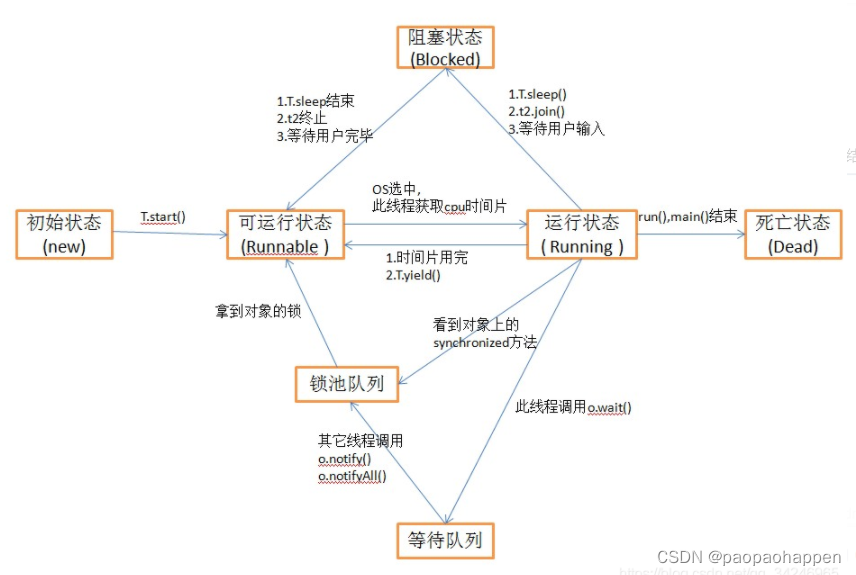Thread.State
源码
/**
* A thread state. A thread can be in one of the following states:
* <ul>
* <li>{@link #NEW}<br>
* A thread that has not yet started is in this state.
* </li>
* <li>{@link #RUNNABLE}<br>
* A thread executing in the Java virtual machine is in this state.
* </li>
* <li>{@link #BLOCKED}<br>
* A thread that is blocked waiting for a monitor lock
* is in this state.
* </li>
* <li>{@link #WAITING}<br>
* A thread that is waiting indefinitely for another thread to
* perform a particular action is in this state.
* </li>
* <li>{@link #TIMED_WAITING}<br>
* A thread that is waiting for another thread to perform an action
* for up to a specified waiting time is in this state.
* </li>
* <li>{@link #TERMINATED}<br>
* A thread that has exited is in this state.
* </li>
* </ul>
*
* <p>
* A thread can be in only one state at a given point in time.
* These states are virtual machine states which do not reflect
* any operating system thread states.
*
* @since 1.5
* @see #getState
*/
public enum State {
/**
* Thread state for a thread which has not yet started.
*/
NEW,
/**
* Thread state for a runnable thread. A thread in the runnable
* state is executing in the Java virtual machine but it may
* be waiting for other resources from the operating system
* such as processor.
*/
RUNNABLE,
/**
* Thread state for a thread blocked waiting for a monitor lock.
* A thread in the blocked state is waiting for a monitor lock
* to enter a synchronized block/method or
* reenter a synchronized block/method after calling
* {@link Object#wait() Object.wait}.
*/
BLOCKED,
/**
* Thread state for a waiting thread.
* A thread is in the waiting state due to calling one of the
* following methods:
* <ul>
* <li>{@link Object#wait() Object.wait} with no timeout</li>
* <li>{@link #join() Thread.join} with no timeout</li>
* <li>{@link LockSupport#park() LockSupport.park}</li>
* </ul>
*
* <p>A thread in the waiting state is waiting for another thread to
* perform a particular action.
*
* For example, a thread that has called <tt>Object.wait()</tt>
* on an object is waiting for another thread to call
* <tt>Object.notify()</tt> or <tt>Object.notifyAll()</tt> on
* that object. A thread that has called <tt>Thread.join()</tt>
* is waiting for a specified thread to terminate.
*/
WAITING,
/**
* Thread state for a waiting thread with a specified waiting time.
* A thread is in the timed waiting state due to calling one of
* the following methods with a specified positive waiting time:
* <ul>
* <li>{@link #sleep Thread.sleep}</li>
* <li>{@link Object#wait(long) Object.wait} with timeout</li>
* <li>{@link #join(long) Thread.join} with timeout</li>
* <li>{@link LockSupport#parkNanos LockSupport.parkNanos}</li>
* <li>{@link LockSupport#parkUntil LockSupport.parkUntil}</li>
* </ul>
*/
TIMED_WAITING,
/**
* Thread state for a terminated thread.
* The thread has completed execution.
*/
TERMINATED;
}
NEW
新建(NEW),表示线程被创建出来还没真正启动的状态,可以认为它是个Java内部状态,即初始化状态。
RUNNALE
可运行(RUNNABLE)线程对象创建后,其他线程(比如main线程)调用了该对象的start()方法。该状态的线程位于可运行线程池中,等待被线程调度选中,获取cpu 的使用权 。
BLOCKED
阻塞(BLOCKED)阻塞状态是指线程因为某种原因放弃了cpu 使用权,也即让出了cpu timeslice,暂时停止运行。直到线程进入可运行(runnable)状态
(一). 等待阻塞:运行(running)的线程执行o.wait()方法,JVM会把该线程放入等待队列(waitting queue),当前线程释放对象锁。
(二). 同步阻塞:运行(running)的线程在获取对象的同步锁时,若该同步锁被别的线程占用,则JVM会把该线程放入锁池(lock pool)中。
(三). 其他阻塞:运行(running)的线程执行Thread.sleep(long ms)或t.join()方法,或者发出了I/O请求时,JVM会把该线程置为阻塞状态,但不释放对象锁。当sleep()状态超时、join()等待线程终止或者超时、或者I/O处理完毕时,线程重新转入可运行(runnable)状态。
WAITING
等待(WAITING),表示正在等待其他线程采取某些操作。一个常见的场景是类似生产者消费者模式,发现任务条件尚未满足,就让当前消费者线程等待(wait),另外的生产者线程去准备任务数据,然后通过类似notify等动作,通知消费线程可以继续工作了。Thread.join()也会令线程进入等待状态。
TIMED_WAITING
计时等待(TIMED_WAITING),其进入条件和等待状态类似,但是调用的是存在超时条件的方法,比如wait或join等方法的指定超时版本,
其他两个状态
RUNNING 和 DEAD两个状态虽然不在Thread.State的枚举中,但却是线程非常重要的状态。
RUNNING
运行(RUNNING)可运行状态(runnable)的线程获得了cpu 时间片(timeslice) ,执行程序代码。
DEAD
死亡(DEAD)线程run()、main() 方法执行结束,或者因异常退出了run()方法,则该线程结束生命周期。死亡的线程不可再次复生。
状态流转图
这里面有个比较重要的点是,当线程A调用了,其中某个对象如对象O的wait后,将进入等待队列,等待其他的线程调用对象O的notify或者notifyAll后,线程A才能进入锁池队列,争抢对象O的锁,拿到对象O的锁,线程A才能回到Runnable的状态。






















 401
401











 被折叠的 条评论
为什么被折叠?
被折叠的 条评论
为什么被折叠?








